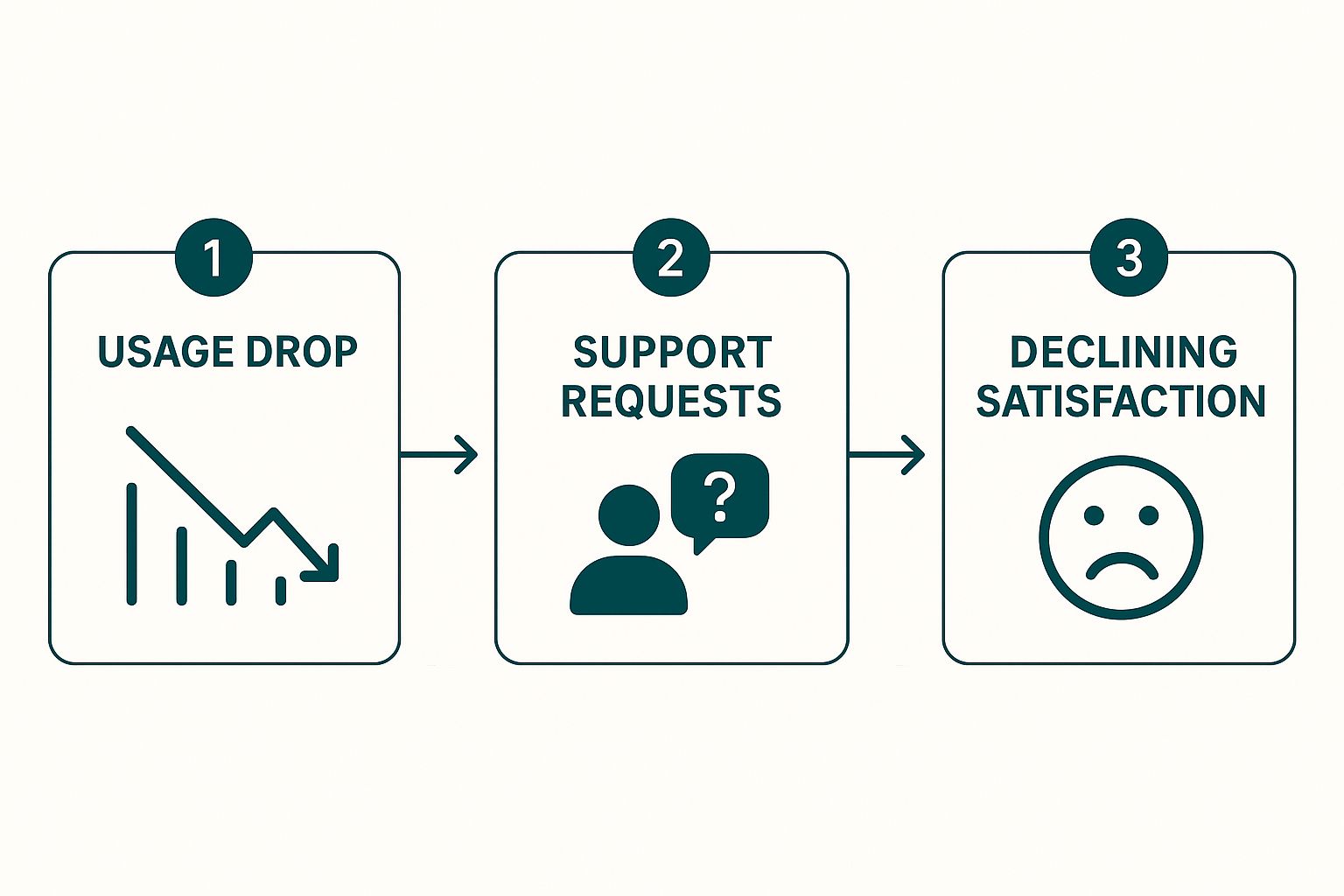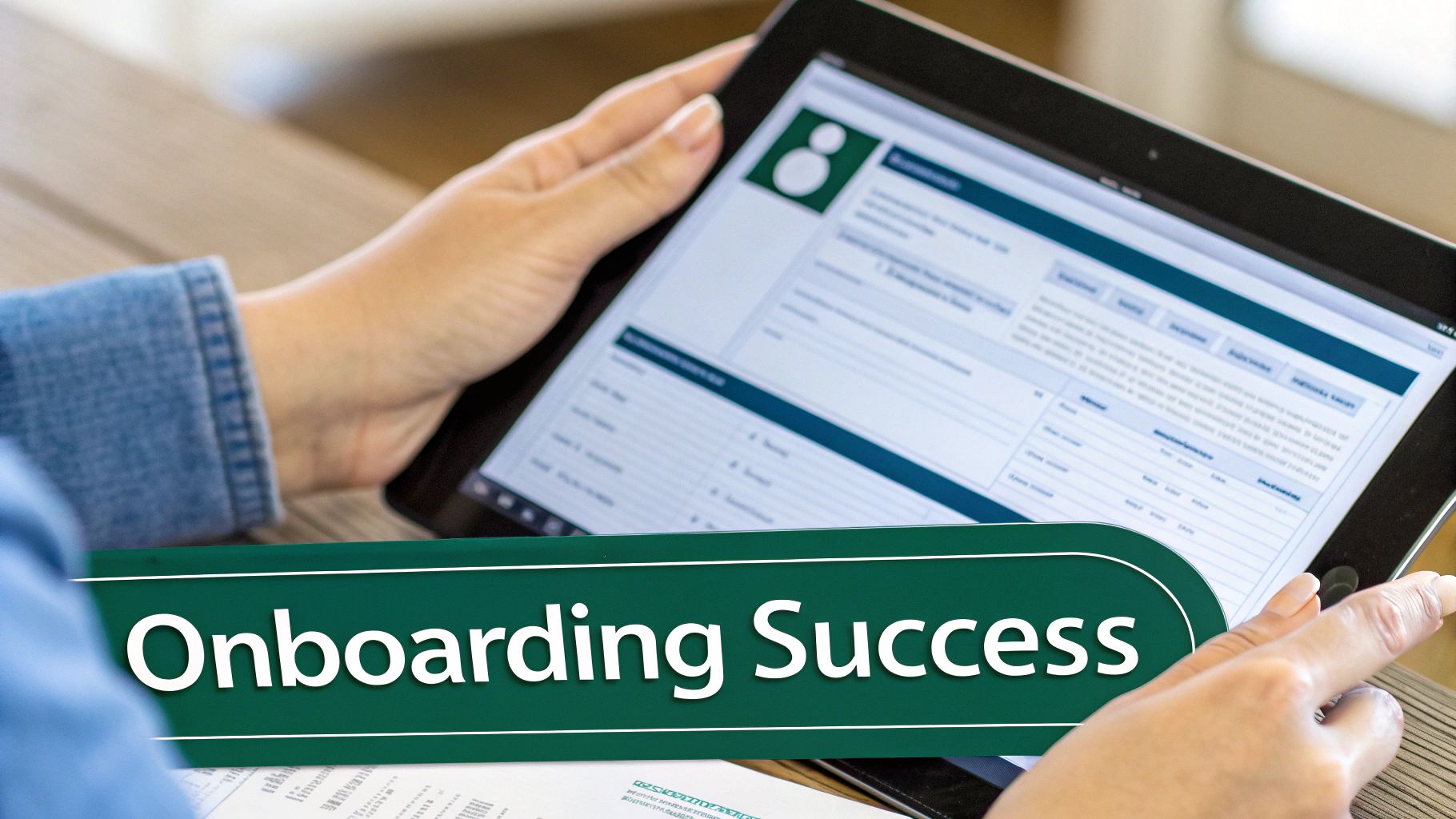If you want to get a real handle on customer churn, you have to stop reacting to it and start getting ahead of it. This means figuring out why customers are leaving in the first place, building systems to engage them proactively, and consistently showing them the value you offer. It’s a shift from patching leaks to preventing them from ever springing up.
Why Understanding Customer Churn Fuels Business Growth

Before you can fix a leaky bucket, you have to find the holes. It’s the same with your business. That churn rate you see on your dashboard isn't just a number; it’s a direct signal about the experience and value you're providing. Getting past a simple definition is the first real step toward building a more resilient company.
The thing is, churn has a snowball effect that goes way beyond just the immediate revenue hit. Every customer who walks away also represents lost potential—no more upsells, no referrals, and no positive word-of-mouth. Over time, a high churn rate can seriously damage your brand's reputation and lock you into an exhausting cycle of expensive customer acquisition, just trying to replace who you've lost.
Churn Is Not One-Size-Fits-All
A huge mistake I see people make is trying to apply a one-size-fits-all fix for churn. The truth is, the reasons customers leave can be wildly different from one industry to another. What makes someone cancel a SaaS subscription is completely different from why they might switch their go-to brand of coffee.
Take the consumer packaged goods (CPG) world, for example. Churn rates there shot up to 40% recently, mostly because of how people’s shopping habits have changed. With 76% of shoppers trying out new brands and different ways to buy, CPG companies had to get a lot smarter about how they connected with customers to stay top-of-mind. It’s worth checking out some industry-specific churn data to see how your own sector stacks up.
Understanding these differences is everything. A software company might need to double down on its user onboarding, whereas an e-commerce store might get better results by improving its customer support and delivery speed.
Key Takeaway: You can't fix churn if you don't understand why it's happening for your specific business. Generic solutions are a waste of time because they almost always miss the real problem.
The Three Pillars of Churn Reduction
To build a retention strategy that actually sticks, you need to focus on three core areas. I think of these as the foundation for everything else you'll do. Getting these pillars right gives you a clear, actionable game plan for cutting down on churn.
This table breaks down the three fundamental strategies for effectively reducing customer churn.
Core Pillars of Churn Reduction
| Pillar | Key Action | Expected Outcome |
|---|---|---|
| Diagnose Churn Drivers | Dig into both quantitative data (like usage stats) and qualitative feedback (like exit surveys) to find the real reasons customers leave. | You'll have a clear picture of your top 3-5 churn reasons, so you can stop guessing and start making targeted fixes. |
| Build Proactive Engagement | Set up automated and manual touchpoints to connect with customers at key moments, long before they show signs of disengaging. | Customers feel supported and valued throughout their entire journey, leading to higher satisfaction and loyalty. |
| Deliver Consistent Value | Keep educating users, pointing out useful features, and making sure your product consistently meets—or even exceeds—their expectations. | Your product becomes stickier and more essential to your customers' daily lives or workflows, making it much harder to leave. |
By building your strategy around these pillars, you shift from playing defense to playing offense. You’re actively making customer relationships stronger and creating a much more stable, predictable business.
Diagnosing Why Your Customers Are Actually Leaving
To get a real handle on customer churn, you need to put on your detective hat. You can't fix a problem if you don't truly understand it, and guessing why customers are walking out the door is a recipe for wasting time and money. The real answers are buried in your data and hiding in plain sight in your customers' feedback.
The trick is to connect the dots between the numbers and the narratives. Your quantitative data tells you what is happening—the cold, hard facts about user behavior. But it’s the qualitative feedback that uncovers the why—the human stories and frustrations that numbers can't explain. When you bring both together, you stop making assumptions and start finding real, actionable solutions.
Uncovering Clues in Your Data
Your own analytics platform is the first place to start your investigation. You're looking for patterns—subtle shifts in behavior that signal a customer might be getting ready to leave. These red flags often appear long before you get that dreaded cancellation email.
Keep a close eye on these behavioral metrics:
- Usage Frequency: Are people logging in less? Did they stop using a core feature that was once central to their workflow? Any sudden drop-off is a major warning sign.
- Support Ticket Volume: A sudden spike in support tickets, especially about the same nagging problems, clearly indicates friction. On the flip side, a customer who was once a frequent contact and then goes completely silent can also be a huge risk.
- Feature Adoption: Are new sign-ups actually finishing your onboarding? Are long-time customers engaging with the new features you’re rolling out? If not, it suggests they aren't finding ongoing value in your product.
It’s easy to get complacent with what looks like a small churn rate, but the numbers can be deceiving. A seemingly low monthly churn of 5% actually means you lose nearly 46% of your customers over the course of a year. If that creeps up to 10% a month, your annual churn explodes to over 70%. That's a massive, leaky bucket.
Interestingly, it's not always about the product itself. External factors like budget cuts or simply not needing the tool as often are common reasons for cancellation. You can dig deeper into the state of customer retention at Churnkey.co to see more trends like this.
Gathering Direct Feedback from the Source
While data shows you what's happening, you have to actually talk to people to find out why. This is where getting qualitative feedback is absolutely critical. Don't be shy about asking direct questions—you'd be surprised how many customers are willing to share their thoughts if you just make it easy for them.
A common mistake is relying solely on automated exit surveys with multiple-choice questions. The real gold is in the open-ended "Why are you leaving?" text box or, even better, a direct conversation.
I once worked with a SaaS company that was seeing a huge drop-off right around the 90-day mark. The data showed a clear dip in usage, but it couldn't tell them the reason. After just a handful of exit interviews, a clear theme emerged. Customers loved the product, but they found adding new team members to their account was a clunky, confusing nightmare. They weren't leaving over price or a lack of features; they were churning because of a frustrating administrative task.
Armed with that specific insight, the product team completely redesigned the team management interface. The result? Churn for that 90-day group fell by 15% the very next quarter. It's a perfect illustration of how pairing data (the usage drop) with direct feedback (the "why") leads to a precise, high-impact fix.
If you’re waiting for customers to complain before you act, you’re already behind. The most powerful way to slash churn isn’t by fixing problems after they happen—it’s by stopping them from ever starting. This means building a system for proactive engagement, where you connect with customers at just the right moments, not just when they’re upset.
Stop hoping customers will stick around and start actively guiding them. A proactive approach is all about consistently delivering value and showing you’re a partner in their success, long before they even think about leaving. It’s the difference between being an indispensable resource and just another line item on their credit card bill.
Think of it like this: a small dip in usage can quickly spiral into support tickets, frustration, and eventually, a cancelled subscription. Proactive engagement is about breaking that chain before it gets started.

This image really drives home how one negative signal can lead to another. The goal is to spot that first sign of trouble—the drop in usage—and step in with a solution.
Pinpoint Your Key Engagement Triggers
First things first, you need to map out the moments in the customer journey where a timely message can make all the difference. These triggers aren't random; they’re based on specific user behaviors that signal either risk or opportunity. When you act on these signals, you can deliver the right message at precisely the right time.
What should you look for? Think about common scenarios that tell you a customer might need a friendly nudge:
- A user hasn’t logged in for 14 days. This is a classic red flag for disengagement. A simple, automated email with a helpful tip or a link to a new feature can be all it takes to bring them back.
- Someone starts clicking around an advanced feature for the first time. Don't let them get stuck and give up. Proactively send them a quick demo video or an invite to a brief one-on-one walkthrough.
- A customer hits a major milestone. Celebrate with them! A quick congratulatory message reinforces the value they're getting and makes them feel good about their choice.
From what I’ve seen, nearly 70% of customers leave simply because they feel a company doesn't care about them. Proactive touchpoints, even small ones, are a direct antidote to this. They show you're paying attention and are genuinely invested in their success.
Set Up Your Engagement Workflows
Once you've identified your triggers, it’s time to build the workflows that act on them. The smartest way to do this is by blending automation for efficiency with a human touch for high-impact interactions.
For example, imagine a user at a SaaS company keeps visiting the API documentation page. An automated email with links to resources is a good starting point. But a truly effective workflow would also create a task for a customer success manager to reach out personally. That human touch can transform a moment of potential frustration into a positive, loyalty-building conversation.
Here’s how you can combine both automated and manual approaches:
| Trigger | Automated Workflow | Manual Workflow |
|---|---|---|
| New feature is ignored | Send a CustomerCloud Broadcast highlighting the feature's benefits and linking to a short tutorial. | If engagement stays low, a success manager follows up with a personal email offering a tailored demo. |
| Usage spikes | Trigger a congratulatory message celebrating their increased activity and suggesting related features. | For high-value accounts, this flags a team member to check in and explore potential upsell opportunities. |
This dual approach lets you efficiently support your entire customer base while still reserving that high-touch, personal experience for the moments—and customers—that matter most. It's a scalable way to make every single customer feel seen and valued.
Using Personalization to Fortify Customer Loyalty

Let's be honest, we've all received those generic, one-size-fits-all emails and immediately hit delete. When every message feels like it was blasted to a thousand other people, it’s easy for your brand to feel cold, distant, and completely replaceable.
The real secret to building loyalty is making each customer feel seen, understood, and genuinely valued. It’s a core human need. When you’re trying to figure out how to reduce customer churn, shifting from mass communication to personal connection is one of the most powerful moves you can make. It’s about more than just slotting a {{first_name}} tag into an email; it's about delivering truly relevant interactions at the right time.
Think Beyond Basic Demographics
The bedrock of real personalization is smarter segmentation. Forget about lumping customers into broad categories like age or location. Modern tools let you get far more granular by grouping people based on what they actually do with your product.
I’ve seen this work wonders. Instead of guessing, you can build dynamic segments around real-world actions. For example:
- Lifecycle Stage: Is someone a brand-new user just getting their bearings, or are they a seasoned power user who lives and breathes your most advanced features? What about the loyal customer who hasn't logged in to see your latest update? Each group needs a different conversation.
- Behavioral Patterns: You could create a segment of users who constantly use one specific feature, another for those whose login frequency has suddenly dropped, or even a group for people who have visited your pricing page more than once this week.
- Support History: Imagine creating a segment of every user who has contacted support about the same bug. Now you can send them a single, targeted update when it’s fixed. That’s powerful.
Using a platform like CustomerCloud, you can define these segments and then use its broadcast features to send precisely tailored messages. A best-practice guide for your "power users" or a gentle nudge with a special offer for those showing signs of slipping away can make all the difference.
When customers feel like a company is speaking directly to their unique needs, they are 74% more likely to feel a sense of loyalty. This emotional connection makes your service feel indispensable, not just another subscription.
Make Every Support Interaction Personal
Nothing sours a relationship faster than feeling like a number in a queue, especially when you're frustrated and need help. The quality of your support experience is a massive factor in whether customers stick around. We're talking about a make-or-break moment.
The numbers don't lie. In the U.S., 59% of customers will likely walk away after a few bad experiences, and a staggering 17% might leave after just one. Even more telling, 67% of consumers will jump ship to a competitor after a single poor interaction. You can dig into more of these eye-opening customer retention statistics at Sprinklr.com.
This is where personalized support becomes your secret weapon. Your team shouldn't have to start every conversation from scratch. They need the full picture. Has this customer contacted support before? What are their most-used features? What's their subscription level?
Having this context turns a generic response into a relevant, empathetic solution. When every interaction is informed and personal, you transform support from a necessary cost into one of your most effective tools for building loyalty that lasts.
So, Are Your Retention Efforts Actually Working?

Rolling out proactive engagement and personalized messages is a solid move. But if you aren't measuring the results, you’re basically flying blind. To get a real grip on how to reduce customer churn, you have to connect your actions to real-world outcomes.
Think of it as creating a feedback loop. This is what allows you to prove your ROI to stakeholders and, more importantly, to keep tweaking your strategy based on what actually works, not just what you think should work.
Look Beyond the Obvious Churn Rate
Your main churn rate is what we call a lagging indicator. It only tells you what’s already happened. To get ahead of the problem, you need to be watching your leading indicators. These are the early warning signs—the subtle clues in customer behavior that give you time to step in before it’s too late.
It’s like the difference between your car’s check engine light and the fuel gauge. The check engine light (a lagging indicator) means there's already a problem. The fuel gauge (a leading indicator) warns you of an issue before you’re stranded on the side of the road.
Here are the vital leading indicators you should be tracking:
- Customer Satisfaction (CSAT): This is a snapshot of happiness right after a specific interaction, like closing a support ticket. A steady dip in CSAT scores is a classic sign of simmering frustration.
- Net Promoter Score (NPS): NPS measures long-term loyalty by asking one simple question: "How likely are you to recommend us?" If your NPS starts to fall, it suggests your overall value is slipping in your customers' eyes.
- Customer Health Score: This is your own custom-built metric. You combine different data points—like login frequency, key feature usage, and recent support tickets—into a single score that tells you if an account is healthy, at-risk, or on its way out.
McKinsey found that companies using predictive analytics to keep an eye on these kinds of indicators can cut churn by up to 15%. They spot disengagement earlier and have a much better shot at successfully re-engaging those customers.
Connecting Your Campaigns to the Bottom Line
This is where the rubber meets the road. You absolutely must be able to link your specific retention campaigns to changes in customer behavior. If you can’t draw that line, you’ll never know which of your brilliant ideas are actually making a difference.
Let’s say you launched a more detailed onboarding sequence last quarter for all new sign-ups. How do you know if it was worth the effort? You have to connect that campaign to tangible results.
Here’s a real-world scenario:
Imagine you used CustomerCloud's broadcast feature to send a five-part educational series to new users during their first 30 days.
To figure out if it worked, you’d need to do a few things:
- Isolate the Group: First, you’d create a segment of every user who went through this new onboarding.
- Compare Against a Control Group: Next, you’d analyze their behavior and compare it to a similar group of users from the previous period who didn't get the new sequence.
- Search for Improvements: Was the new group adopting key features faster? Did they log fewer support tickets in their first month? And the big one: is their 90-day retention rate higher?
With the right analytics dashboard, you can see these comparisons side-by-side. When you find that the group who received the onboarding broadcasts has a 10% higher retention rate after three months, you’ve got cold, hard proof that your strategy is paying off.
This kind of data-driven thinking turns retention from a guessing game into a repeatable science. It creates a powerful cycle where you launch, measure, learn, and then refine your approach, getting better and better at keeping the customers you worked so hard to win.
Got Questions About Churn? We've Got Answers
Tackling customer churn can feel like a huge undertaking, and it's natural to have questions. We hear a lot of the same ones from businesses trying to get a handle on their retention, so we’ve put together some straight-to-the-point answers based on what we see every day.
What’s Actually a “Good” Churn Rate?
Honestly, there's no universal magic number. A good churn rate is completely relative to your business model and who you serve.
For instance, a SaaS company selling to large enterprises might have a fantastic monthly churn rate of 1-2%. But a similar business focused on small businesses or solopreneurs could see rates between 3-7% and still be doing quite well. They're just operating in a more volatile market.
Don't get too hung up on industry benchmarks. The real win is understanding your number, figuring out what's driving it, and seeing it trend downward over time. Focus on making steady progress, not hitting some abstract ideal.
How Should I Approach Different Kinds of Churn?
It's critical to distinguish between voluntary churn (when a customer actively decides to cancel) and involuntary churn (when a subscription ends due to a failed payment). You can't fix them with the same strategy.
- To combat voluntary churn, you have to get to the root of why they're leaving. This means proactively engaging them, constantly reinforcing your value, and actually listening to their feedback. It's all about making your product indispensable.
- Fixing involuntary churn is more of a technical problem. This is where automated payment reminders and dunning campaigns come in. A simple, automated nudge can often resolve a billing issue before it ever becomes a cancellation.
A surprising amount of churn is completely accidental and preventable. Tightening up your billing processes is often the lowest-hanging fruit for boosting your retention numbers.
I'm a Small Business. Where on Earth Do I Start?
If you're just getting started and feeling overwhelmed, forget the fancy analytics and predictive models for now. Your most powerful first step is incredibly simple: talk to the customers who just left.
Pick up the phone and call a few of them. A five-minute, honest conversation will give you more actionable insight than you'd get from staring at a spreadsheet for a week. Ask them point-blank why they canceled and what, if anything, could have made them stay.
This direct feedback is pure gold. It will immediately illuminate your biggest problems and show you exactly where to focus your efforts first.
Ready to turn churn signals into loyal customers? With CustomerCloud, you can unify your communications, track engagement, and build proactive retention workflows all in one place. See how our platform can help you keep the customers you’ve worked so hard to win. Explore CustomerCloud today.